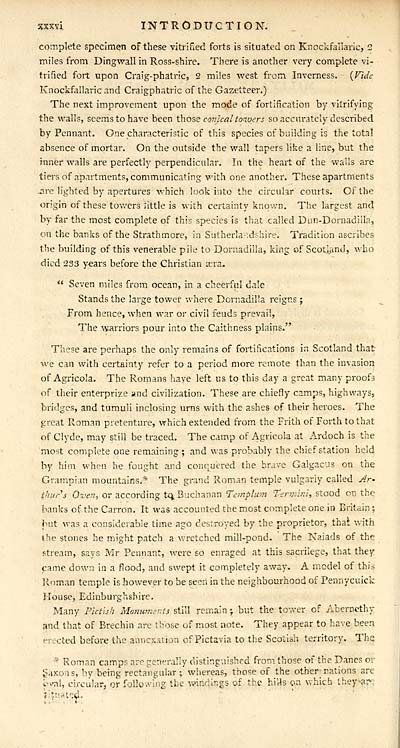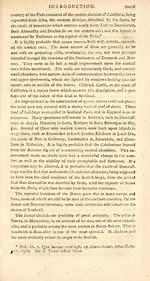Gazetteer of Scotland
(48) Page xxxvi
Download files
Complete book:
Individual page:
Thumbnail gallery: Grid view | List view

xxxvi INTRODUCTION.
complete specimen of these vitrified forts is situated on Knockfallaric, 2
miles from Dingwall in Ross-shire. There is another very complete vi-
trified fort upon Craig-phatric, 2 miles west from Inverness. - {Fide
Knockfallaric and Craigphatric of the Gazetteer.)
The next improvement upon the mode of fortification by vitrifying
the walls, seems to have been those conical towers so accurately described
by Pennant. One characteristic of this species of building is the total
absence of mortar. On the outside the wall tapers like a line, but the
inner walls are perfectly perpendicular. In the heart of the walls are
tiers of apartments, communicating with one another. These apartments
-are lighted by apertures which look into the circular courts. Of the
origin of these towers little is with certainty known. The largest and
by far the most complete of this species is that called Dun-Dornadilla,
on the banks of the Strathmore, in Sutherlaodshire. Tradition ascribes
the building of this venerable pile to Dornadilla, king of Scotland, who
died 233 years before the Christian tera.
" Seven miles from ocean, in a cheerful dale
Stands the large tower where Dornadilla reigns ;
From hence, when war or civil feuds prevail,
The warriors pour into the Caithness plains."
These are perhaps the only remains of fortifications in Scotland that
we can with certainty refer to a period more remote than the invasion
of Agricola. The Romans have left us to this day a great many proofs
of their enterprize and civilization. These are chiefly camps, highways,
bridges, and tumuli inclosing urns with the ashes of their heroes. The
great Roman pretenture, which extended from the Frith of Forth to that
of Clyde, may still be traced. The camp of Agricola at Ardoch is the
most complete one remaining ; and was probably the chief station held
by him when he fought and conquered the brave Galgac'Js on the
Grampian mountains.* The grand Roman temple vulgarly called Ar-
thur's Oven, or according tqt Buchanan Templum termini, stood on the
banks of the Carron. It was accounted the most complete one in Britain ;
but was a considerable time ago destroyed by the proprietor, thai with
the stones he might patch a wretched mill-pond. The Naiads of the
stream, says Mr Pennant, were so enraged at this sacrilege, that they
came down in a flood, and swept it completely away. A model of this
Roman temple is however to be seen in the neighbourhood of Pennycuick
House, Edinburghshire.
Many Pictish Monuments still remain ; but the tower of Abernethy
?md that of Brechin are those of most note. They appear to have been
erected before the annexation of Pictavia to the Scotish territory. The
* Roman camps are generally distinguished from those of the Danes or
gaxons, by being rectangular; whereas, those of the other nations are
bval, circular, or following the windings of the hills on which ihey-ar--
si^iatqd.
complete specimen of these vitrified forts is situated on Knockfallaric, 2
miles from Dingwall in Ross-shire. There is another very complete vi-
trified fort upon Craig-phatric, 2 miles west from Inverness. - {Fide
Knockfallaric and Craigphatric of the Gazetteer.)
The next improvement upon the mode of fortification by vitrifying
the walls, seems to have been those conical towers so accurately described
by Pennant. One characteristic of this species of building is the total
absence of mortar. On the outside the wall tapers like a line, but the
inner walls are perfectly perpendicular. In the heart of the walls are
tiers of apartments, communicating with one another. These apartments
-are lighted by apertures which look into the circular courts. Of the
origin of these towers little is with certainty known. The largest and
by far the most complete of this species is that called Dun-Dornadilla,
on the banks of the Strathmore, in Sutherlaodshire. Tradition ascribes
the building of this venerable pile to Dornadilla, king of Scotland, who
died 233 years before the Christian tera.
" Seven miles from ocean, in a cheerful dale
Stands the large tower where Dornadilla reigns ;
From hence, when war or civil feuds prevail,
The warriors pour into the Caithness plains."
These are perhaps the only remains of fortifications in Scotland that
we can with certainty refer to a period more remote than the invasion
of Agricola. The Romans have left us to this day a great many proofs
of their enterprize and civilization. These are chiefly camps, highways,
bridges, and tumuli inclosing urns with the ashes of their heroes. The
great Roman pretenture, which extended from the Frith of Forth to that
of Clyde, may still be traced. The camp of Agricola at Ardoch is the
most complete one remaining ; and was probably the chief station held
by him when he fought and conquered the brave Galgac'Js on the
Grampian mountains.* The grand Roman temple vulgarly called Ar-
thur's Oven, or according tqt Buchanan Templum termini, stood on the
banks of the Carron. It was accounted the most complete one in Britain ;
but was a considerable time ago destroyed by the proprietor, thai with
the stones he might patch a wretched mill-pond. The Naiads of the
stream, says Mr Pennant, were so enraged at this sacrilege, that they
came down in a flood, and swept it completely away. A model of this
Roman temple is however to be seen in the neighbourhood of Pennycuick
House, Edinburghshire.
Many Pictish Monuments still remain ; but the tower of Abernethy
?md that of Brechin are those of most note. They appear to have been
erected before the annexation of Pictavia to the Scotish territory. The
* Roman camps are generally distinguished from those of the Danes or
gaxons, by being rectangular; whereas, those of the other nations are
bval, circular, or following the windings of the hills on which ihey-ar--
si^iatqd.
Set display mode to: Large image | Transcription
Images and transcriptions on this page, including medium image downloads, may be used under the Creative Commons Attribution 4.0 International Licence unless otherwise stated. ![]()
| Gazetteers of Scotland, 1803-1901 > Gazetteer of Scotland > (48) Page xxxvi |
|---|
| Permanent URL | https://digital.nls.uk/97415138 |
|---|

